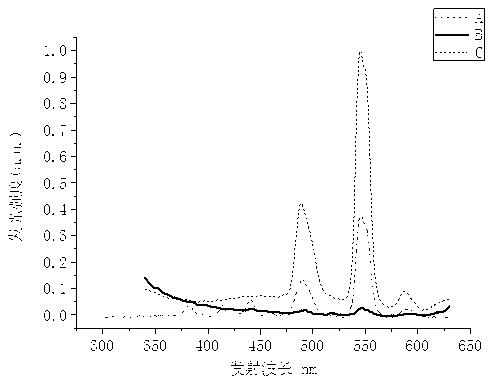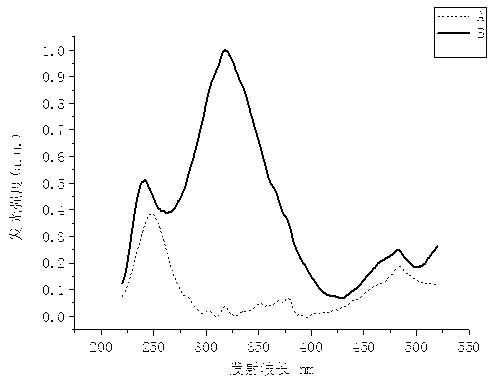Preparation method for sensitization-enhanced green light-emitting high-silica glass
A technology of high silica glass and borosilicate glass, which is applied in the field of preparation of sensitized and enhanced green light-emitting high silica glass, can solve the problems of difficult integration, human harm, and insufficient luminous intensity.
- Summary
- Abstract
- Description
- Claims
- Application Information
AI Technical Summary
Problems solved by technology
Method used
Image
Examples
Embodiment 1
[0026] Take analytically pure chemical reagents according to SiO 2 63.72mol%, Na 2 CO 3 9.80 mol%, H 3 BO 3 26.48 mol% of mixed materials are prepared. After mixing and grinding uniformly, it is put into a platinum crucible, and after being melted at a high temperature of 1450°C for 40 minutes, it is cooled and molded on an iron plate at 400°C to prepare borosilicate glass.
[0027] The borosilicate glass was placed in a high-temperature furnace and subjected to a heat treatment at 590°C for 20 hours, and then cut into glass pieces of 5 mm×5 mm×1 mm. Put the glass in a sealed autoclave and place it at 98°C for three 24 hours of acid treatment; the first time is immersed in a 1mol / L nitric acid solution at a ratio of 50ml acid solution / g glass, and the second time Immerse in 1mol / L nitric acid solution at the ratio of 10ml acid solution / g glass, and immerse in 0.3mol / L nitric acid solution at the ratio of 10ml acid solution / g glass for the third time. Then the glass is taken o...
Embodiment 2
[0033] Take analytically pure chemical reagents according to SiO 2 52.07mol%, Na 2 CO 3 5.82 mol%, H 3 BO 3 39.17 mol %, Al(OH) 3 2.94mol% of mixed materials are prepared. After mixing and grinding uniformly, it is put into a corundum crucible, and after being melted at a high temperature of 1400°C for 60 minutes, it is cooled and molded on an iron plate at 300°C to prepare borosilicate glass.
[0034] The borosilicate glass was put into a high-temperature furnace and subjected to a heat treatment at 560° C. for 40 hours, and then cut into 5 mm×5 mm×1 mm glass pieces. Put the glass in a sealed autoclave and place it at 90°C for three 12-hour acid treatments; the first time is immersed in a 1mol / L hydrochloric acid solution at a ratio of 50ml acid solution / g glass, and the second to Dip into 1mol / L hydrochloric acid solution three times at the ratio of 10ml acid solution / g glass. Then the glass is taken out of the autoclave, washed with distilled water, and dried to obtain hi...
Embodiment 3
[0037] Take analytically pure chemical reagents according to SiO 2 62.81mol%, Na 2 CO 3 10.15 mol%, H 3 BO 3 27.04 mol% of mixed materials are prepared. After mixing and grinding uniformly, it is put into a corundum crucible, after being melted at a high temperature of 1500°C for 30 minutes, it is cooled and molded on an iron plate at 200°C to prepare borosilicate glass.
[0038] The borosilicate glass was put into a high-temperature furnace and subjected to a heat treatment at 630°C for 10 hours, and then cut into 5mm×5mm×1mm glass pieces. Put the glass in a sealed autoclave, immerse it in a 1mol / L nitric acid solution at a ratio of 50ml acid solution / g glass, and place it at 100°C for a 48-hour acid treatment. Then take the glass out of the autoclave, wash it with distilled water, and dry it to obtain porous glass.
[0039] Use Tb 4 O 7 And Eu(NO 3 ) 3 Prepare a mixed solution containing 0.01mol / L Tb ion and 0.01mol / L Eu ion with nitric acid solution. The aforementioned high...
PUM
 Login to View More
Login to View More Abstract
Description
Claims
Application Information
 Login to View More
Login to View More - Generate Ideas
- Intellectual Property
- Life Sciences
- Materials
- Tech Scout
- Unparalleled Data Quality
- Higher Quality Content
- 60% Fewer Hallucinations
Browse by: Latest US Patents, China's latest patents, Technical Efficacy Thesaurus, Application Domain, Technology Topic, Popular Technical Reports.
© 2025 PatSnap. All rights reserved.Legal|Privacy policy|Modern Slavery Act Transparency Statement|Sitemap|About US| Contact US: help@patsnap.com


